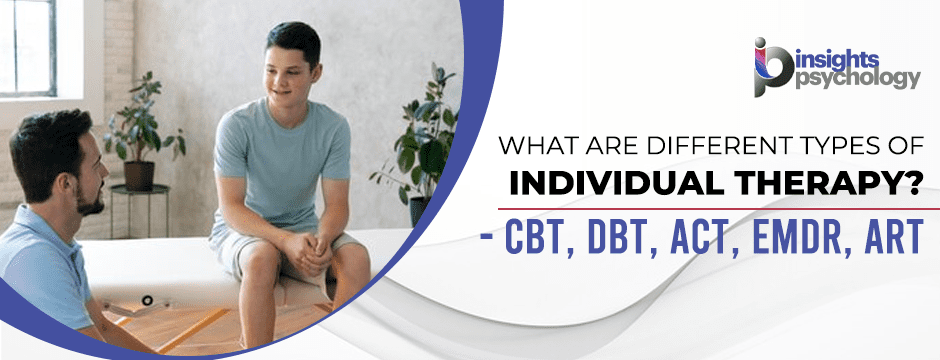In a world where mental health is increasingly prioritized, individual therapy has become a cornerstone for addressing emotional, psychological, and behavioral challenges. With numerous therapeutic approaches available, it can feel overwhelming to determine which one might be the best fit for your needs. This article dives deep into five widely recognized forms of individual therapy: Cognitive Behavioral Therapy (CBT), Dialectical Behavior Therapy (DBT), Acceptance and Commitment Therapy (ACT), Eye Movement Desensitization and Reprocessing (EMDR), and Accelerated Resolution Therapy (ART). By understanding the nuances of each, you can make an informed decision on your path to healing.
The Importance of Individual Therapy
Individual therapy, also known as talk therapy or psychotherapy, is a collaborative process where clients work one-on-one with a trained therapist. The goal is to explore thoughts, emotions, and behaviors to foster self-awareness, overcome challenges, and achieve personal growth. Whether you’re struggling with anxiety, depression, trauma, or relationship issues, therapy provides a safe and confidential space to unpack your feelings and develop actionable strategies for change.
Therapy is not one-size-fits-all. Different methods cater to different needs, offering unique tools and frameworks to address specific concerns. Understanding these approaches empowers you to select the therapy that resonates most with your personal goals and circumstances.
1. Cognitive Behavioral Therapy (CBT)
What is CBT? Cognitive Behavioral Therapy is one of the most researched and widely practiced therapeutic approaches. Developed in the 1960s by Dr. Aaron Beck, CBT focuses on the connection between thoughts, feelings, and behaviors. The premise is simple: by identifying and challenging distorted thought patterns, individuals can alter their emotions and behaviors.
How Does CBT Work? CBT is typically short-term and structured, making it a practical choice for those seeking actionable results. A CBT session might involve:
- Identifying negative or irrational thoughts (e.g., “I’m a failure”).
- Challenging these thoughts with evidence-based reasoning.
- Replacing them with healthier, more constructive beliefs.
- Engaging in behavioral experiments to reinforce positive changes.
CBT often incorporates homework assignments, such as journaling or practicing new coping strategies, to extend the benefits of therapy into daily life.
Who Can Benefit from CBT? CBT is highly effective for a wide range of conditions, including:
- Anxiety disorders
- Depression
- Phobias
- Obsessive-compulsive disorder (OCD)
- Post-traumatic stress disorder (PTSD)
- Insomnia
- Chronic pain management
Why Choose CBT? CBT is goal-oriented, time-efficient, and backed by decades of research. It equips clients with practical tools to manage challenges independently, making it an empowering approach. Its adaptability also makes it suitable for diverse populations, from children to older adults.
2. Dialectical Behavior Therapy (DBT)
What is DBT? Originally developed by Dr. Marsha Linehan for individuals with borderline personality disorder (BPD), Dialectical Behavior Therapy has expanded to treat a variety of conditions. DBT emphasizes balancing acceptance with change and is rooted in mindfulness practices.
Core Components of DBT: DBT is structured around four key modules:
- Mindfulness: Cultivating awareness of the present moment without judgment.
- Distress Tolerance: Building resilience to cope with crises without resorting to harmful behaviors.
- Emotion Regulation: Understanding and managing intense emotions.
- Interpersonal Effectiveness: Navigating relationships with assertiveness and respect.
DBT sessions often include both individual therapy and group skills training, offering a comprehensive approach to emotional and behavioral challenges.
Who Can Benefit from DBT? While initially designed for BPD, DBT is now widely used to treat:
- Emotional dysregulation
- Chronic suicidal thoughts
- Self-harm behaviors
- Eating disorders
- Substance use disorders
- PTSD
Why Choose DBT? DBT’s unique combination of mindfulness and skill-building makes it especially effective for individuals who struggle with intense emotions and interpersonal conflicts. Its emphasis on acceptance provides a compassionate framework for clients to address their challenges while working toward meaningful change.
3. Acceptance and Commitment Therapy (ACT)
What is ACT? Acceptance and Commitment Therapy is a mindfulness-based approach that encourages individuals to accept their thoughts and feelings rather than fighting or avoiding them. Developed by Dr. Steven Hayes in the 1980s, ACT helps clients align their actions with their core values.
How Does ACT Work? ACT uses six core principles:
- Cognitive Defusion: Learning to see thoughts as mere words or images, reducing their power.
- Acceptance: Allowing uncomfortable emotions to exist without resistance.
- Contact with the Present Moment: Staying grounded in the here and now.
- Self-as-Context: Viewing oneself as separate from one’s thoughts and feelings.
- Values Clarification: Identifying what truly matters to you.
- Committed Action: Taking steps aligned with your values, even in the face of discomfort.
Who Can Benefit from ACT? ACT is effective for:
- Anxiety and depression
- Chronic pain
- Stress management
- PTSD
- Obsessive-compulsive tendencies
- Coping with health conditions like cancer or diabetes
Why Choose ACT? ACT’s focus on mindfulness and values-based living makes it a transformative approach for those seeking to break free from avoidance behaviors and build a meaningful life. It’s particularly beneficial for individuals dealing with chronic or existential challenges, offering a sense of purpose and direction.
4. Eye Movement Desensitization and Reprocessing (EMDR)
What is EMDR? Eye Movement Desensitization and Reprocessing is a specialized therapy designed to alleviate distress associated with traumatic memories. Developed by Dr. Francine Shapiro in the late 1980s, EMDR facilitates the brain’s natural healing process.
How Does EMDR Work? EMDR involves eight structured phases, including:
- History Taking: Assessing the client’s background and identifying target memories.
- Preparation: Building trust and teaching coping strategies.
- Assessment: Focusing on a specific memory and its associated beliefs and emotions.
- Desensitization: Using bilateral stimulation (e.g., guided eye movements) to process the memory.
- Installation: Strengthening positive beliefs associated with the memory.
- Body Scan: Identifying and resolving residual physical tension.
- Closure: Ensuring emotional stability at the end of each session.
- Reevaluation: Reviewing progress and identifying new targets if needed.
Who Can Benefit from EMDR? EMDR is particularly effective for trauma-related conditions, including:
- PTSD
- Childhood abuse
- Sexual assault
- Grief and loss
- Phobias
- Performance anxiety (e.g., public speaking)
Why Choose EMDR? EMDR provides rapid relief from trauma without requiring extensive verbal processing, making it a valuable option for individuals who find it difficult to talk about their experiences. It is also highly adaptable, allowing therapists to tailor sessions to each client’s pace and comfort level.
5. Accelerated Resolution Therapy (ART)
What is ART? Accelerated Resolution Therapy is a relatively new, evidence-based approach that combines elements of CBT, EMDR, and guided visualization. Developed by Laney Rosenzweig in 2008, ART aims to resolve distressing memories and emotional pain quickly and effectively.
How Does ART Work? ART sessions often involve:
- Voluntary Image Replacement: Clients visualize distressing memories and replace them with positive imagery.
- Bilateral Stimulation: Guided eye movements facilitate memory processing.
- Narrative Rewriting: Clients reframe their experiences to reduce emotional intensity.
Who Can Benefit from ART? ART has been shown to help with:
- Trauma and PTSD
- Anxiety and depression
- Phobias
- Grief and loss
- Relationship issues
- Sleep disturbances
Why Choose ART? ART’s focus on rapid symptom relief makes it an appealing choice for individuals seeking efficient and effective therapy. Many clients report significant improvements in just 1-5 sessions, making it ideal for those who need immediate results.
Choosing the Right Therapy for You
While all these therapies share a common goal—to improve mental health and well-being—their methods and philosophies differ. Here are some factors to consider when choosing a therapeutic approach:
- Your Specific Needs: Are you dealing with trauma, anxiety, emotional dysregulation, or another challenge?
- Your Preferences: Do you prefer structured, goal-oriented sessions (CBT), or are you drawn to mindfulness and acceptance-based practices (ACT, DBT)?
- Therapist Expertise: Seek a licensed therapist with specialized training in your preferred approach.
- Time Commitment: Some therapies, like ART and EMDR, can provide rapid results, while others, like DBT, may require longer-term commitment. Additionally, consider how much time you can realistically dedicate to therapy sessions and any accompanying practices like homework or mindfulness exercises.
- Personal Comfort: Therapy is a deeply personal journey. Feeling comfortable with the therapeutic process and the therapist is crucial to its success.
- Cost and Accessibility: Check whether the therapy is covered by insurance or falls within your budget. Some therapies may also require specific resources, such as group sessions (DBT) or specialized equipment (EMDR).
The Growing Role of Therapy in Mental Wellness
As the stigma surrounding mental health continues to diminish, the role of individual therapy in promoting mental wellness becomes increasingly evident. Whether you’re grappling with life’s challenges or seeking deeper self-awareness, these diverse therapeutic approaches offer tools to navigate your unique circumstances.
From CBT’s structured, evidence-based techniques to ART’s rapid emotional relief, each therapy has distinct advantages. Exploring these options with an open mind and a qualified professional can help you unlock the most effective path to emotional well-being and personal growth.
Final Thoughts
Choosing the right type of individual therapy can be transformative, paving the way for healing and resilience. Remember, you don’t have to navigate this decision alone. Consulting with a licensed therapist or counselor can provide valuable insights and help match you with the approach that aligns best with your needs.
At Insights Psychology, we’re dedicated to guiding you through your mental health journey. Whether you’re considering CBT, DBT, ACT, EMDR, or ART, our experienced team is here to support you every step of the way. Don’t hesitate to take the first step—reach out today to discover the therapy that’s right for you.
By embracing therapy and investing in your mental health, you’re choosing a brighter, more fulfilling future.
Big changes start with a conversation. Read ‘How to Talk to Your Child About Starting Therapy.’

